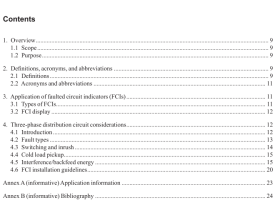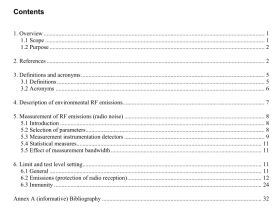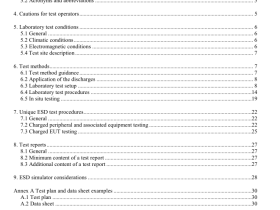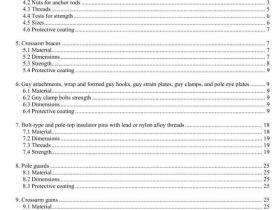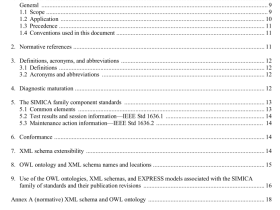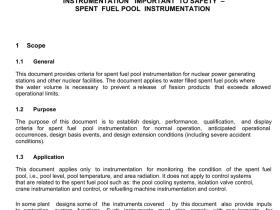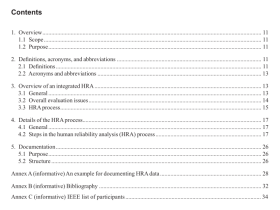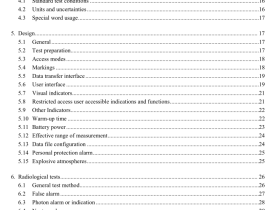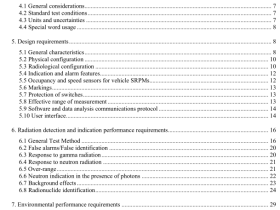IEEE Std 1594 pdf download
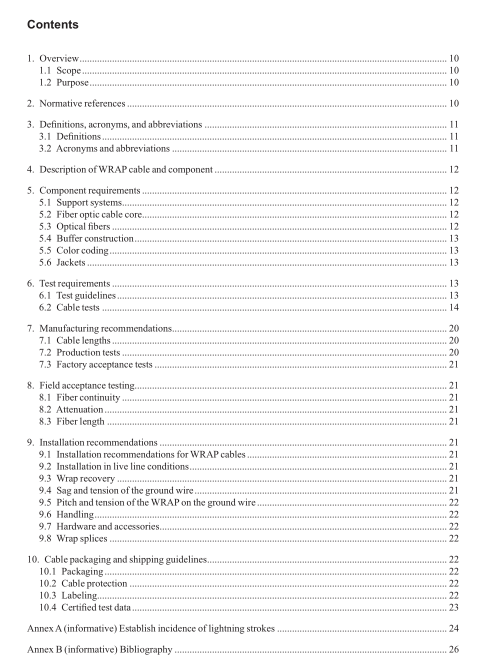
IEEE Std 1594 pdf download IEEE Standard for Helically-Applied Fiber Optc Cable Systems (WRAP) for Use on Overhead Utlity Lines
Where fiber loss measurements are required, at least ten fibers, or 100% of the fibers if less than ten fibers, ofthe test cable shall be mcasured for optical attenuation or attenuation change. Where the fibers are housed inmore than one loose tube, the number selected from each tube shall be equal.
6.2 Cable tests
6.2.1 Design tests
AWRAP cable shall successfully pass the design tests discussed in 6.2.1.1,6.2.1.2, and 6.2.1.3.However,design tests may be waived at the option of the user if a WRAP cable of equivalent design has already beensuccessfully tested.
6.2.1.1 Waterblocking test
A waterblocking test shall be performed.No water shall leak through the open end of the sample.
A waterblocking test for cable shall be made in accordance with the requirements for TIA/EIA 455-82B,except that the test length shall be 1 m.
6.2.1.2 Seepage and filling/flooding compound test
For filled/flooded fiber optic cable, seepage of filling/flooding compound test shall be performed.The fillingand flooding compound shall not flow (drip or leak) at 65 C.
A0.3 m sample of cable shall be tested in accordance with TIA/EIA455-8lB.The optional preconditioningcycle as described in TIA/EIA 455-81B may be used. The unprepared cable end may be scaled.
6.2.1.3 Aeolian vibration test
An acolian vibration test shall be carried out. As the combinations of wrapped cables and ground wirelconductor/messenger wire are significant,a representative test can be performed for a family of cablecombinations. Any damage that will affect the mechanical performance of the cable or causes a permanentor temporary increase in optical attenuation greater than 1.o dB/test fiber km (defined as the actual fiber inthe vibration test span) at 1550 nm±20 nm for single-mode fibers, or 1300 nm ± 20 nm for multimode fibers,shall constitute failure. There shall be no breach of the jacket after the test. The objective of this test is toassess the fatigue performance of the WRAP cable and the ground wire on which it is installed and the opticalcharacteristics of the fibers under typical aeolian vibrations.
6.2.1.3.1 Test setup
The general arrangement to be used for the aeolian vibration tests and the support details are shown in(Annex A).The end abutments are used to load and maintain tension in the conductor or ground wire on whichthe WRAPcable is installed (in the correct manner so as to simulate its installation on the line).The test sectionis contained between the two intermediate abutments.End and intermediate abutments need not be separateunits if the combined unit affords sufficient space for the setup.The fiber optic cable to be tested shall be cuta sufficient length beyond the intermediate abutments to allow removal of the cable coverings and to allowaccess to the optical fibers. Suitable dead-end assemblies or end abutments are installed on ground wire orconductor to fit between the intermediate abutments. The test sample shall be terminated at both ends prior totensioning in a manner such that the optical fibers cannot move relative to the cable.The load during the testshall be monitored using a dynamometer, load cell, calibration beam, or other device.Some means shall beprovided to maintain constant tension to allow for temperature fluctuations during the testing.The conductoror ground wire shall be tensioned to 100% of its rated maximum installation tension.
In order to achieve repeatability of test results, the active span shall be 20 m or more in length, with a suitablesuspension assembly located approximately two-thirds of the distance between the two dead-end assemblies.
Longer active and/or back spans may be used. (see Figure A.I)The suspension assembly shall be supported ata height such that the static sag angle of the cable to the horizontal is 11/%°±1/4° in the active span.
Means shall be provided for measuring and monitoring the mid-loop (antinode) vibration amplitude at a freeloop, not a support loop.
An electronically controlled shaker shall be used to excite the cable in the vertical plane.The shaker armatureshall be securely fastened to the cable so that it is perpendicular to the cable in the vertical plane.The shakershall be located in the span to allow for a minimum of six vibration loops between the suspension assemblyand the shaker.
The test length (i.e., between the dead-end assemblies) of the optical fiber shall be a minimum of 100 m.To achieve this length several fibers may be spliced together. At least one fiber shall be tested from eachbuffer tube or fiber bundle. Measurements shall be made using a light source with a nominal wavelength of1550 nm±20 nm for single-mode fibers and a nominal wavelength of 1300 nm±20 nm for multimode fibers.
The source shall be split into two signals.One signal shall be connected to an optical power meter and shall actas a reference. The other signal shall be connected to a free end of the test fiber. The returning signal shall beconnected to a second optical power meter.All optical connections and splices shall remain intact through theentire test duration.
